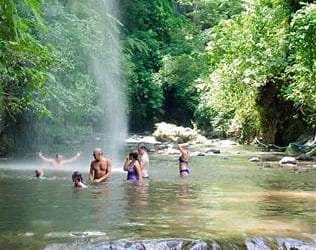Where Experienced Surfers Go in Costa Rica During the Mini Summer to Escape Crowds and Chase Monster Sets
Where are the best waves in Costa Rica during the mini summer?
During Costa Rica’s short dry spell in July, known as the veranillo de San Juan, the Pacific coast lights up with powerful swells. Experienced surfers know this window is gold: strong southern swells, smaller crowds, and glassy mornings. While the popular spots like Tamarindo and Santa Teresa pull in the usual mix of surf schools and sun-chasers, the real action is a little off the map.
What makes the mini summer special for surfing?
The mini summer brings consistent surf, less rain, and ideal offshore winds. It’s a break in the rainy season that turns the ocean into a playground for those in the know. While tourists are dodging cloudbursts, local surfers are waxing their boards and whispering about their favourite breaks.

Which secret spots do seasoned surfers prefer?
Veteran wave chasers often skip the overhyped beaches and head for lesser-known zones that only turn on with July’s swell angles.
- Pavones’ Little Brother (Cabo Matapalo)
Though Pavones gets all the fame, the nearby Cabo Matapalo offers heavy rights and fewer boards in the water. It’s jungle-fringed and wild, with waves that can jack up quickly when the swell gets serious. - Playa Negra (but not that one)
There’s more than one Playa Negra in Costa Rica, and seasoned surfers don’t always mean the Guanacaste version. Head south and you’ll find lesser-known “negras” that pump in July and are suspiciously quiet. - Ollie’s Point on a Mission
Accessible only by boat from Playas del Coco or Playa Hermosa (GTE), Ollie’s Point offers world-class rights—if you can time the tides and winds. July often lines up just right. You’ll need a captain who knows his swell charts and maybe a cooler of Imperial. - Playa Junquillal’s Hidden Corners
Not far from Avellanas but dramatically less crowded, Junquillal holds sneaky rights and lefts along its rocky outcrops. The beach isn’t always forgiving, but for those who know where to paddle out, it’s a dream. - Nosara’s North End
While the town itself is no longer a secret, the northern stretch past Ostional offers less crowded reef breaks that come alive during the mid-year pulse.
Why do surfers seek these less-known breaks?
It’s not just about bragging rights. These spots offer more power, less drop-in drama, and a chance to ride waves in a setting that feels raw and untamed. The mini summer creates a sweet spot—less mud, less wind chop, more swell—and the best sessions often happen with no spectators.
What should surfers know before heading to secret spots?
Getting to these places often means 4WD roads, long paddles, or chartering a boat. Local knowledge is essential—not just to find the waves but to stay safe.
- Check conditions obsessively
July swells are reliable but can shift. Use local forecast tools and tide charts religiously. - Respect the locals
Some secret breaks come with silent rules. Be cool, wait your turn, and smile. You’re in paradise, not a heat. - Pack for the mission
Bring extra fins, reef booties, snacks, and a healthy respect for rips and reefs. The jungle doesn’t always come with a surf shop.
FAQ
Is the mini summer consistent every year in Costa Rica?
It typically appears around mid-to-late July, but intensity and duration can vary. Some years bring a solid two-week dry window, while others might offer just a few epic days.
Do you need a guide to find secret surf breaks?
It’s highly recommended unless you’re deeply familiar with the coastline. A local surf guide can help you hit the right spots at the right time.
Are these spots suitable for beginners?
Not usually. Many of these waves break over reefs or rocky points and are better suited to intermediate and advanced surfers.
What are the best times of day to surf during July?
Early mornings often bring the best wind conditions—typically glassy with offshore breezes. Afternoons can bring onshore chop or brief tropical showers.
Do I need a special board for these waves?
Bring your step-up if you’re hunting bigger sets. Many July swells deliver more power than your average beach break.
How can I avoid crowds while surfing in Costa Rica?
Skip the usual tourist surf towns and look for remote stretches of coast with challenging access. The further you’re willing to go, the emptier the line-up.
Are surf charters worth it in July?
Absolutely. Especially for hard-to-reach spots like Ollie’s Point or Witches Rock. July often brings perfect conditions for a boat mission.
Can I combine surfing with other activities during the mini summer?
Yes. The veranillo offers dry trails for jungle hikes, better wildlife visibility, and warm water for snorkelling or diving between sessions.
What’s the weather like outside of surf conditions?
Expect warm days with occasional showers. Nights are cooler, and the humidity dips compared to the heart of the rainy season.
Are accommodations cheaper during the mini summer?
In many areas, yes. July isn’t peak high season, so you can often score a better deal, especially if you book away from the mainstream surf zones.
Is the mini summer a good time for surf photographers?
Definitely. The combination of dramatic skies, clean waves, and golden light makes July a prime time for capturing powerful sessions on camera.How can I meet other experienced surfers in Costa Rica?
Check out surf hostels near advanced breaks or connect through local surf shops. The best way in is usually a shared session and a post-surf beer.






